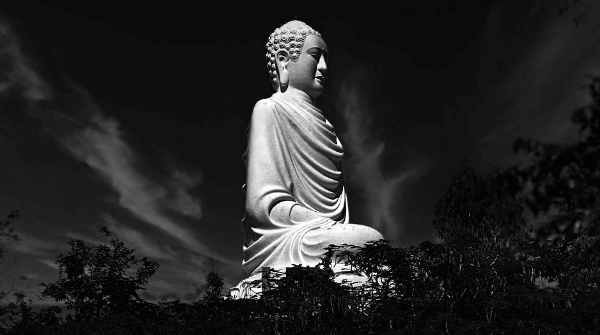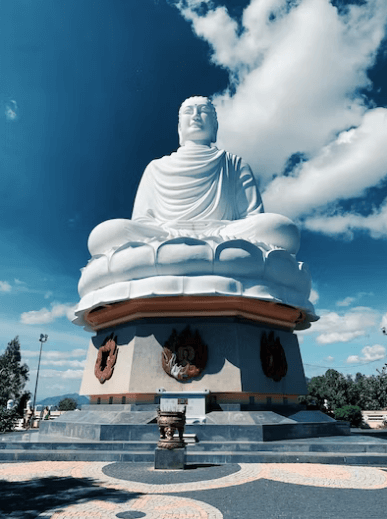Long Son Pagoda
This place is a renowned Buddhist temple which is known for its stunning architecture, tranquil atmosphere, and beautiful gardens.
Long Son Pagoda is a true gem of Vietnamese culture and architecture.
Its towering white Buddha statue, intricate murals, and beautiful gardens are a testament to the skill and dedication of the temple's craftsmen and artists.
Whether you are a history buff, a lover of art and architecture, or simply seeking a peaceful and spiritual atmosphere, Long Son Pagoda is an absolute must-visit destination in Nha Trang, Vietnam.
The temple is a popular tourist destination, attracting visitors from all over the world. However, there is much more to this temple than meets the eye. In this article, we will explore the history, architecture, and lesser-known facts about the Long Son Pagoda.Photo: The peaceful site of Long Son Pagoda.
History of Long Son Pagoda
Long Son Pagoda was originally built in the late 19th century during the reign of Emperor Thành Thái. It was first named Dang Long Tu, which translates to "Palace of the Dragon," and was located at the foot of Trai Thuy Mountain. However, in 1900, the temple was destroyed by a severe storm. It was then relocated to its current location at the top of the hill, where it has remained ever since.
READ ALSO: Stunning Water Falls near Nha Trang
The construction of the current temple was initiated by Buddhist monk Thich Nguyen Thanh in 1940. It was completed in 1943 and has been a significant religious site in Nha Trang ever since. Over the years, the temple has undergone several renovations and expansions to accommodate the growing number of visitors.Architecture of Long Son Pagoda
The most striking feature of Long Son Pagoda is the towering white Buddha statue, which stands at a height of 24 meters. The statue was built in 1963 and is visible from many parts of the city. It is made of concrete and has a beautiful lotus-shaped base.
The temple complex also features a three-tiered roof with intricate carvings and dragon motifs. The roofs are adorned with red and gold colors, which symbolize prosperity and good fortune. The temple's main hall, known as the Hoa Nghiem, features several Buddhist statues and is used for prayer and meditation.
One of the unique architectural features of Long Son Pagoda is the Buddhist art depicted on the walls. The temple's walls are covered in elaborate murals that depict various Buddhist stories and teachings. The murals were painted by skilled artists from Hue, a city famous for its traditional art and architecture.Lesser-known Facts about Long Son Pagoda
In addition to its striking architecture and unique features, Long Son Pagoda has a long and fascinating history. From its origins in the late 19th century to its use as a revolutionary base during the Vietnam War, the temple has played a significant role in shaping the history of Nha Trang and Vietnam as a whole.
Despite its popularity as a tourist destination, there are many lesser-known facts and features of Long Son Pagoda that are rarely written about on the internet.
Whether it's the temple's role in a historic protest against the French colonial government, its community of resident monks, or the sacred Cu Rua turtle that calls its pond home, there is always something new to discover and learn about this remarkable temple.Here are a few interesting tidbits..
1. Long Son Pagoda was used as a revolutionary base during the Vietnam War. In the 1960s, the temple was used as a safe haven for communist soldiers who were fighting against the South Vietnamese government and their American allies.
2. The temple is home to a large community of monks who live and study on the premises. Visitors can participate in meditation classes and interact with the monks to learn more about their daily lives.
3. The temple is also known for its beautiful gardens, which feature a wide variety of plants and flowers. Visitors can stroll through the gardens and enjoy the peaceful surroundings.4. Long Son Pagoda has a special significance for the Vietnamese people, as it was the site of a historic protest against the French colonial government. In 1927, a group of Buddhist monks and civilians marched to the temple to protest the French government's decision to close down a local language school. The protest was successful, and the school was allowed to remain open.
5. The temple is home to a rare species of turtle called the Cu Rua. This turtle is considered sacred by the Vietnamese people and is believed to bring good luck and prosperity. The turtle can often be seen swimming in the temple's pond, which is located at the base of the hill.
Book your Favorite Tour here..



